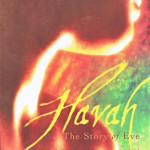 Today the spotlight shines on……………………………………………………Havah and Adam
Today the spotlight shines on……………………………………………………Havah and Adam

Tosca Lee’s Havah is a transformational book and I can’t recommend it highly enough. Tosca’s writing it evocative, challenging and masterful and Havah is a testament to her gift with the written word. Tosca has put a lot into this spotlight ~ please enjoy it and we would love your comments!
Brief physical description
 Havah is a tall, colt-legged, dark-skinned girl-woman. Her hair is woolly and black, her cheeks high. She is a natural runner with lean legs, flat feet, and narrow hips. She is physically very strong… Her skin, once flawless, is ashen and dry and worn from her life outside the garden. Her heels are cracked and lined with calluses like shoes. Her knees are scraped and dry, her cuticles are crusted with earth… Her hair is showing grey, her breasts are limp, her hips are uneven and spread apart. But she still loves to run.
Havah is a tall, colt-legged, dark-skinned girl-woman. Her hair is woolly and black, her cheeks high. She is a natural runner with lean legs, flat feet, and narrow hips. She is physically very strong… Her skin, once flawless, is ashen and dry and worn from her life outside the garden. Her heels are cracked and lined with calluses like shoes. Her knees are scraped and dry, her cuticles are crusted with earth… Her hair is showing grey, her breasts are limp, her hips are uneven and spread apart. But she still loves to run.
 Adam is a boy of a man, darker-skinned than Havah, with obsidian shadow along his jaw. His mouth is round and full—“like a leave that drips water to thirsty lips,” Havah says. His face is smooth and his eyes are blue. His hair is black and curling. His legs are thewed and strong—his arms have become leaner as he has grown to manhood… The planes of his chest are broad and lean, the cut of his jaw sharpened beneath his beard, his shoulders corded from the hoe. His arms are black from the sun, his forehead is furrowed and small lines turn from the corners of his once-full mouth… He cries in his sleep sometimes in old age.
Adam is a boy of a man, darker-skinned than Havah, with obsidian shadow along his jaw. His mouth is round and full—“like a leave that drips water to thirsty lips,” Havah says. His face is smooth and his eyes are blue. His hair is black and curling. His legs are thewed and strong—his arms have become leaner as he has grown to manhood… The planes of his chest are broad and lean, the cut of his jaw sharpened beneath his beard, his shoulders corded from the hoe. His arms are black from the sun, his forehead is furrowed and small lines turn from the corners of his once-full mouth… He cries in his sleep sometimes in old age.
Actor/famous person who might resemble her/him
For Havah, the closest thing I could find to her was a leggy dark-skinned model from an ad for some tropical island, but I admit to shamelessly casting a younger Shemar Moore as Adam.
Rel:~ We couldn’t find the tropical island ad but we thought actress and model, Aishwarya Rai, a good pick for Havah in her younger days.
Strengths and weaknesses
Havah:
Runs as fast as a lion. Questions everything. Seeks God. Wants to know—everything. Places undue pressure on her eldest son.
Adam:
Steadfast and loyal. Innovative. Hides pain. Has trouble adjusting to his eldest son’s presence in his life with Havah. Quirk (if any)
Quirk (if any)
Havah:
Loves licorice root. Has prophetic dreams.
Adam:
Once spent an indeterminate amount of time with God before Havah’s creation. Likes to carve—most notably a pendant for Havah. Snores.
Your inspiration for the character
Havah came as an old woman’s voice to me—a woman late in life, reflecting back on her story, very similar to the beginning of Out of Africa, my favorite movie.
Background to the story
Genesis 1-4. Havah’s musings throughout the book come in snippets of idyllic prose mostly inspired by Song of Songs.
Tosca’s Havah Trivia
The location of the garden is loosely based on the Zagros Mountain Range area in loose accordance with David Rohl’s hypothesis in Legend, including mention of the waters of the abyss, which come from within the mountain’s volcanic crater.
All character names, other than Adam’s and Abarja’s (which is Parsi), a re taken from Hebrew names and have specific meaning for each character, including animal names. All central character names are non-transliterated Hebrew names. This was done with the intention of escaping the “Adam and Eve” stereotype.
Speculation about the primitive beginnings of pottery include the ritual or accidental firing of clay men—and human observation of the clay’s changed properties afterward.
Some theologians believe that the two cherubs guarding the gateway to the garden is an early representation of the throne seat later found on the ark of the covenant.
Jewish myth has it that Adam’s first wife was a woman named Lilith. She is replaced by Eve when she will not submit to Adam, and becomes a demon. The origin of the word “lullaby” is a derivative of “Lilith be gone.”
The “forbidden fruit” was not likely to be an apple. Nor was it probable th at Adam and Eve were white, as often depicted in paintings. Nor did the serpent likely resemble a modern-day snake.
It is possible for a dark-skinned Adam to have had blue eyes.
The author wrote up to 10,000 words a day four days in a row to complete this novel—approximately 40 pages a day, or 160 pages in four days. 
The plant that Kanit ingests that nearly kills her is based on belladonna.
“Ish” and “Isha,” Adam and Havah’s pet names for one another mean, loosely and merely, “man” and “woman.”
Adam is referred to as “the adam” until Eve is properly named—at which point he becomes Adam—because he never has a true proper name. Ha-adam, which means “human” or “earthling” or possibly “man from red earth” never means more than that.
The dance that the adam does when Havah comes to life, stomping the ground and clapping his hands, is loosely based on the natural response of spontaneous dance, and loosely based on Somalian dance.
In addition to scripture, apophyphal and pseudepigraphic texts, the Midrash and theological commentary, the author researched flora and fauna of th e Zagros mountain region and Iraq, history of the Levant and Mesopotamia, horticulture, plant propagation, ancient pottery, early farming and crops, the looting of the Baghdad museum, child bearing and rearing, hemp, flax, ancient textiles and weaving, early metal-making, properties of obsidian, flint and quartz, wolves, hide tanning, basket-weaving (no kidding), mud brick-making, ancient instruments and tools, fire-making, bird calls, herbivorous versus carnivorous birds (for various scenes prior to and after the fall), strange earth phenomena and the universe’s early expansion.
e Zagros mountain region and Iraq, history of the Levant and Mesopotamia, horticulture, plant propagation, ancient pottery, early farming and crops, the looting of the Baghdad museum, child bearing and rearing, hemp, flax, ancient textiles and weaving, early metal-making, properties of obsidian, flint and quartz, wolves, hide tanning, basket-weaving (no kidding), mud brick-making, ancient instruments and tools, fire-making, bird calls, herbivorous versus carnivorous birds (for various scenes prior to and after the fall), strange earth phenomena and the universe’s early expansion.
The author donated more than eighty books and DVDs on a variety of these topics to her local library upon completion of the manuscript.
Havah: The Story of Eve
Tosca Lee
Myth and legend shroud her in mystery. Now hear her story.
From paradise to exile, from immortality to the death of Adam. Visit the dawn of mankind through the eyes of Eve—the woman first known as…
Havah
“A passionate and riveting story of the Bible’s first woman and her remarkable journey after being cast from paradise. Lee’s superior storytelling will have readers weeping for all that Havah forfeited by a single damning choice.”
—Publishers Weekly (starred review)
“Once every few years, I come across a book of such scope, such beauty, that it defies description. Havah bridges mankind’s beginnings with the restless state of our present age. . . . Havah is a novel with boundless imagination.”
— Eric Wilson, author of Field of Blood and Fireproof
Prologue
I have seen paradise and ruin. I have known bliss and terror.
I have walked with God.
And I know that God made the heart the most fragile and resilient of organs, that a lifetime of joy and pain might be encased in one mortal chamber. I still recall my first moment of consciousness—an awareness I’ve never seen in the eyes of any of my own children at birth: the sheer ignorance and genius of consciousness, when we know nothing and accept everything.
Of course, the memory of that waking moment is fainter now, like the smell of the soil of that garden, like the leaves of the fig tree in Eden after dawn—dew and leaf green. It fades with that sense of something once tasted on the tip of the tongue, savored now in memory, replaced by the taste of something similar but never quite the same.
His breath a lost sough, the scent of earth and leaf mold that was his sweaty skin has faded too quickly. So like an Eden dawn—dew on fig leaves.
His eyes were blue, my Adam’s.
How I celebrated that color, shrouded now in shriveled eyelids—he who was never intended to have even a wrinkle! But even as I bend to smooth his cheek, my hair has become a white waterfall upon his Eden—flesh and loins that gave life to so many.
I think for a moment that I hear the One and that he is weeping. It is the first time I have heard him in so long, and my heart cries out: He is dead! My father, my brother, my love!
I envy the earth that envelopes him. I envy the dust that comes of him and my children who sow and eat of it.
This language of Adam’s—the word that meant merely “man” before it was his name—given him by God himself, is now mine. And this is my love song. I will craft these words into the likeness of the man before I, too, return to the earth of Adam’s bosom.
My story has been told in only the barest of terms. It is time you heard it all. It is my testament to the strength of the heart, which has such capacity for joy, such space for sorrow, like a vessel that fills and fills without bursting.
My seasons are nearly as many as a thousand. So now listen, sons, and hear me, daughters. I, Havah, fashioned by God of Adam say this:
In the beginning, there was God . . .
But for me, there was Adam.
Tosca Lee is the author of the critically acclaimed Demon: A Memoir (2007), a ForeWord Magazine Book of the Year Silver Award winner, American Christian Fiction Writers Book of the Year nominee, and Christy award finalist. Visit Tosca at her site: www.toscalee.com.
Thanks, Tosca ~ loved the extra details about your story and appreciate the effort that went into researching and writing Havah! Can’t wait to discover your next writing project!

On Thursday, I will be spotlighting Brandt Dodson’s Daniel Borden and a bonus spotlight on Elvis, Daniel’s dog and my first animal spotlight!
Don’t miss it 🙂
Relz Reviewz Extras
Review of Havah













February 2, 2009 at 1:48 am
Great spotlight. I adore Tosca and loved Havah. It was my #1 favorite read in 2008. I can’t wait to see what she writes next.
February 2, 2009 at 2:24 am
I can’t wait to read this one. Thanks for the spotlight as it really does sound very fascinating on many levels
February 2, 2009 at 5:05 am
Rel you’ve been raving about this book for so long that I’m really looking forward to doing it for book club.I know I’m going to come back and re-read this spotlight then too. Tosca, thank you for the extra details.
February 2, 2009 at 3:26 pm
Tosca is nothing short of an amazing writer. Am I the only one who found this novel painful to read? Meaningful and important but oh so painful to face oneself in our origin. This one and Demon . . . a memoir should be required reading for Christians. (If you get a chance, Rel, read my review and tell me what you think.)
February 2, 2009 at 10:24 pm
This book sounds amazing – you have me wanting to read it after reading the amazing, detailed spotlight. Thanks for all the effort you both went to!
February 21, 2009 at 6:06 pm
Wonderful! I too just finished reading the books, Havah and Demon, both of these books are just phenomenal! Thank you for the great post!
March 30, 2009 at 8:22 am
I have just finished reading the book & have thoroughly enjoyed it. The descriptive language is just amazing and I really enjoyed having the peoms scattered throughout the book.
June 7, 2009 at 1:24 pm
Because of your Spotlight, I have added Havah to our Book Club list. I have several ladies previewing books and this one came back as "WOW, this has to be added to our list!"
Thanks Rel!
July 1, 2020 at 11:13 am
I’ve read your post, and have in order to say – this is a real gem.
The last time I’ve arrive across something both equally well-written was https://solothurnclassics.ch/. Your material is
generally a fantastic read, thank you. Wish you the large audience plus inspiration for more posts.